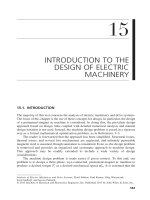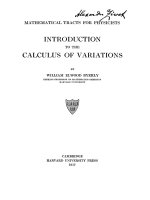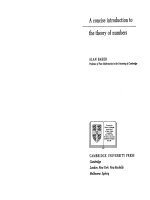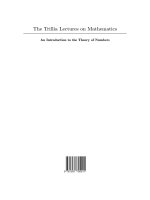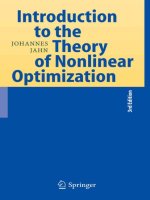- Trang chủ >>
- Khoa Học Tự Nhiên >>
- Vật lý
14 Introduction to the Classical andQuantum Theory of Radiation byAccelerating Charges
Bạn đang xem bản rút gọn của tài liệu. Xem và tải ngay bản đầy đủ của tài liệu tại đây (215.15 KB, 3 trang )
14
Introduction to the Classical and
Quantum Theory of Radiation by
Accelerating Charges
In Part I, Chapters 1–13, we dealt with the polarization of the optical field and the
phenomenological interaction of polarized light with optical components, namely,
polarizers, retarders, and rotators. All this was accomplished with only the classical
theory of light. By the mid-nineteenth century Fresnel’s theory of light was a complete triumph. The final acceptance of the wave theory took place when Stokes
showed that the Fresnel–Arago interference laws could also be explained and understood on the basis of classical optics. Most importantly, Stokes showed that unpolarized light and partially polarized light were completely compatible with the
wave theory of light. Thus, polarized light played an essential role in the acceptance
of this theory. We shall now see how polarized light was again to play a crucial role
in the acceptance of an entirely new theory of the optical field, namely, Maxwell’s
theory of the electrodynamic field.
In spite of all of the successes of Frensel’s theory there was an important
problem that classical optics could not treat. We saw earlier that the classical optical
field was described by the wave equation. This equation, however, says nothing
about the source of the optical field. In 1865 James Clerk Maxwell introduced a
totally new and unexpected theory of light. Maxwell’s new theory was difficult to
understand because it arose not from the description of optical phenomena but from
a remarkable synthesis of the laws of the electromagnetic field. This theory was
summarized by expressing all of the known behavior of the electromagnetic field
in the form of four differential equations. In these equations a source term existed in
the form of a current j(r, t) along with a new term postulated by Maxwell, namely,
the displacement current @D(r, t)/@t.
After Maxwell had formulated his equations, he proceeded to solve them. He
was completely surprised at his results. First, when either the magnetic or electric
field was eliminated between the equations, he discovered that in free space
the electromagnetic field was described by the wave equation of classical optics.
The next result surprised him even more. It appeared that the electromagnetic
field propagated at the same speed as light. This led him to speculate that, perhaps,
Copyright © 2003 by Marcel Dekker, Inc. All Rights Reserved.
the optical field and the electromagnetic field were actually manifestations of the
same disturbance, being different only in their frequency (wavelength).
Maxwell died in 1879. Nearly 10 years later Heinrich Hertz (1888) carried out
a set of very sophisticated and brilliant experiments and confirmed Maxwell’s
theory. In spite of Hertz’s verification, however, Maxwell’s theory was not immediately adopted by the optics community. There were several reasons for this. One
reason was due to the simple fact that Hertz confirmed Maxwell’s theory not
at optical wavelengths but at millimeter wavelengths. For the optical community
this was not enough. In order for them to accept Maxwell’s theory, it would
have to be proved at optical wavelengths. Another reason for the slow acceptance
of Maxwell’s theory was that for 30 years after the publication of Maxwell’s theory
in 1865 nothing had been found which could clearly differentiate between the
classical wave theory and Maxwell’s theory. Nothing had appeared in optics
which was not known or understood using Fresnel’s theory; no one yet understood
exactly what fluorescence or the photoelectric effect was. There was, however,
one very slim difference between the two theories. Maxwell’s theory, in contrast
to Fresnel’s theory, showed that in free space only transverse waves existed. It was
this very slim difference that sustained the ‘‘Maxwellians’’ for several decades. A
third important reason why Maxwell’s theory was not readily embraced by the
optics community was that a considerable effort had to be expended to study
electromagnetism–a nonoptical subject–in order to understand fundamental optical
phenomena. Furthermore, as students to this day know, a fair degree of mathematical training is required to understand and manipulate Maxwell’s equations
(this was especially true before the advent of vector analysis). It was, therefore,
very understandable why the optics community was reluctant to abandon a theory
that explained everything in a far simpler way and accounted for all the known
facts.
In 1896, less than a decade after Hertz’s experiments, two events took place
which overthrew Fresnel’s elastic theory of light and led to the complete acceptance
of Maxwell’s theory. The first was the discovery by J. J. Thomson of the electron, the
long-sought source of the optical field, and the second was the splitting of unpolarized spectral lines which became polarized when an electron was placed in a magnetic
field (the Lorentz–Zeeman effect). In this part we shall see how polarized light played
a crucial role in the acceptance of Maxwell’s theory. We shall use the Stokes parameters to describe the radiation by accelerating electrons and see how the Stokes
parameters and the Stokes vector take on a surprising new role in all of this. In the
final chapter of this part we shall show that the Stokes vector can be used to describe
both classical and quantum radiating systems, thereby providing a single description
of radiation phenomena.
REFERENCES
Books
1.
Maxwell, J. C., A Treatise on Electricity and Magnetism, 3rd ed., Clarendon Press,
Oxford, 1892.
2. Hertz, H., Electric Waves, Macmillan, London, 1893.
3. Lorentz, H. A., The Theory of the Electron, Dover, New York, 1952.
Copyright © 2003 by Marcel Dekker, Inc. All Rights Reserved.
4.
5.
6.
7.
8.
9.
10.
Born, M. and Wolf, E., Principles of Optics, 3rd ed., Pergamon Press, New York,
1965.
Whittaker, E., A History of the Theories of Aether and Electricity, Philosophical Society,
New York, 1951, Vol. I.
Sommerfeld, A., Lectures on Theoretical Physics, Vols. I–V, Academic Press, New York,
1952.
Stratton, J. A., Electrodynamic Theory, McGraw-Hill, New York, 1941.
Feuer, L. S., Einstein and the Generations of Science, Basic Books, New York, 1974.
Jammer, M., The Philosophy of Quantum Mechanics, Wiley, New York, 1974.
Schwinger, J., Einstein’s Legacy, Scientific American Books, Inc., New York, 1986.
Copyright © 2003 by Marcel Dekker, Inc. All Rights Reserved.


